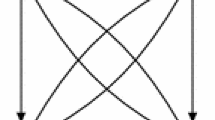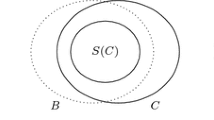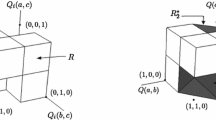Abstract
Various Condorcet consistent social choice functions based on majority rule (tournament solutions) are considered in the general case, when ties are allowed: the core, the weak and strong top cycle sets, versions of the uncovered and minimal weakly stable sets, the uncaptured set, the untrapped set, classes of k-stable alternatives and k-stable sets. The main focus of the paper is to construct a unified matrix-vector representation of a tournament solution in order to get a convenient algorithm for its calculation. New versions of some solutions are also proposed.
Similar content being viewed by others
References
Fishburn P. (1977) Condorcet social choice functions. SIAM J. Appl. Math. 33: 469–489
Miller N. (1980) A new solution set for tournaments and majority voting: further graph-theoretical approaches to the theory of voting. Am. J. Pol. Sci. 24: 68–96
Richelson, J.T.: Majority Rule and Collective Choice. Mimeo (1981)
Bordes G. (1983) On the possibility of reasonable consistent majoritarian choice: some positive results. J. Econ. Theory 31: 122–132
McKelvey R. (1986) Covering, dominance and institution-free properties of social choice. Am. J. Pol. Sci. 30: 283–314
Duggan, J.: Uncovered sets. Mimeo (2006)
Duggan J. (2007) A systematic approach to the construction of non-empty choice sets. Soc. Choice Welf 28: 491–506
Wuffl A., Feld S., Owen G. (1989) Finagle’s law and the Finagle’s point, a new solution concept for two-candidate competition in spatial voting games without a core. Am. J. Pol. Sci. 33(2): 348–375
Aleskerov F., Kurbanov E. (1999) A degree of manipulability of known social choice procedures. In: Alkan A., Aliprantis Ch., Yannelis N. (eds) Current Trends in Economics: Theory and Applications. Springer, Berlin, pp 13–27
Subochev, A.: Dominant, weakly stable, uncovered sets: properties and extensions. Working paper (preprint) WP7/2008/03. Moscow: State University, Higher School of Economics (2008)
Ward B. (1961) Majority rule and allocation. J. Confl. Resolut. 5: 379–389
Schwartz T. (1970) On the possibility of rational policy evaluation. Theory Decis. 1: 89–106
Schwartz T. (1972) Rationality and the myth of the maximum. Noûs. 6: 97–117
Schwartz T. (1977) Collective choice, separation of issues and vote trading. Am. Pol. Sci. Rev. 71(3): 999–1010
Good I. (1971) A note on Condorcet sets. Public Choice 10: 97–101
Smith J. (1973) Aggregation of preferences with variable electorates. Econometrica 41(6): 1027–1041
Aleskerov F., Subochev A. (2009) On stable solutions to the ordinal social choice problem. Doklady Math. 73(3): 437–439
Subochev A. (2010) Dominating, weakly stable, uncovered sets: properties and extensions. Avtomatika i Telemekhanika (Automation & Remote Control) 1: 130–143
McGarvey D. (1953) A theorem on the construction of voting paradoxes. Econometrica 21: 608–610
Laslier J.F. (1997) Tournament Solutions and Majority Voting. Springer, Berlin
Gillies, D.B.: Solutions to general non-zero-sum games. In: Tucker, A.W., Luce, R.D. Contributions to the Theory of Games, vol. IV, Princeton University Press, Princeton (1959)
Banks J. (1985) Sophisticated voting outcomes and agenda control. Soc. Choice Welf 1: 295–306
Miller N. (1977) Graph-theoretical approaches to the theory of voting. Am. J. Pol. Sci. 21: 769–803
Deb R. (1977) On Schwartz’s rule. J. Econ. Theory 16: 103–110
Roth A. (1976) Subsolutions and the supercore of cooperative games. Math. Oper. Res. 1(1): 43–49
von Neumann J., Morgenstern O. (1944) Theory of Games and Economic Behavior. Princeton University Press, Princeton
Laffond G., Lainé J. (1994) Weak covering relations. Theory Decis. 37: 245–265
Levchenkov, V.: Cyclic Tournaments: A Matching Solution. Mimeo (1995)
Zhu X. et al (2010) New dominating sets in social networks. J. Glob. Optim. 48(4): 633–642
Thai M., Pardalos P.M. (2011) Handbook of Optimization in Complex Networks: Communication and Social Networks. Springer, Berlin
Bomze I.M., Budinich M., Pardalos P.M., Pelillo M. (1999) The maximum clique problem. In: Du D.-Z., Pardalos P.M. (eds) Handbook of Combinatorial Optimization, Supplement, vol. A. Kluwer, Dordrecht, pp 1–74
Xanthopoulos P., Arulselvan A., Boginski V., Pardalos P.M. (2009) A retrospective review of social networks. In: Memon N., Alhajj R. (eds) Proceedings of International Conference on Advances in Social Network Analysis and Mining. IEEE Computer Society, Washington, DC, pp 300–305
Author information
Authors and Affiliations
Corresponding author
Rights and permissions
About this article
Cite this article
Aleskerov, F., Subochev, A. Modeling optimal social choice: matrix-vector representation of various solution concepts based on majority rule. J Glob Optim 56, 737–756 (2013). https://doi.org/10.1007/s10898-012-9907-2
Received:
Accepted:
Published:
Issue Date:
DOI: https://doi.org/10.1007/s10898-012-9907-2




